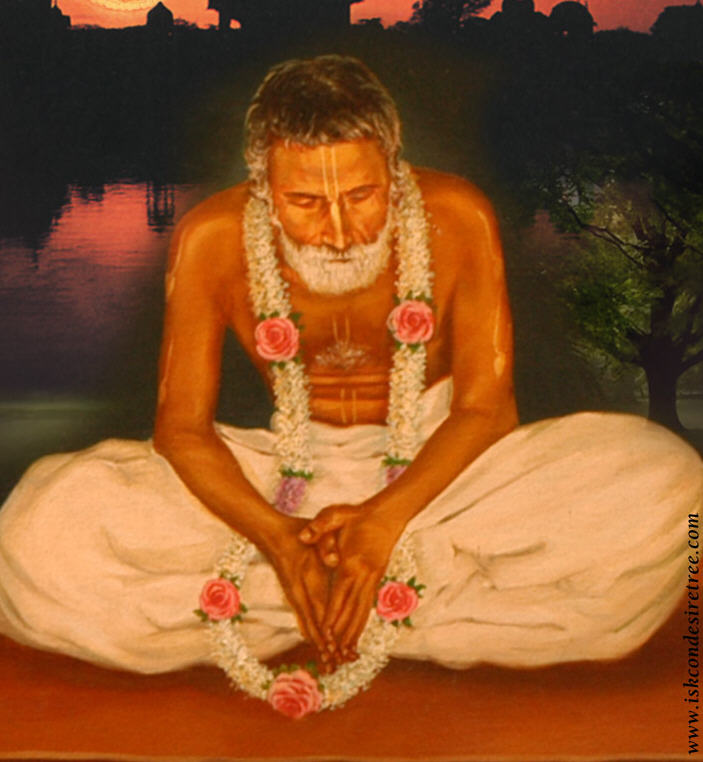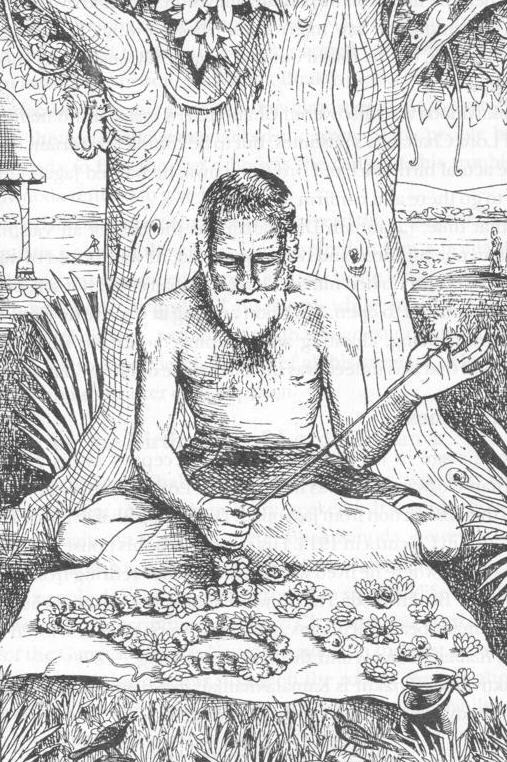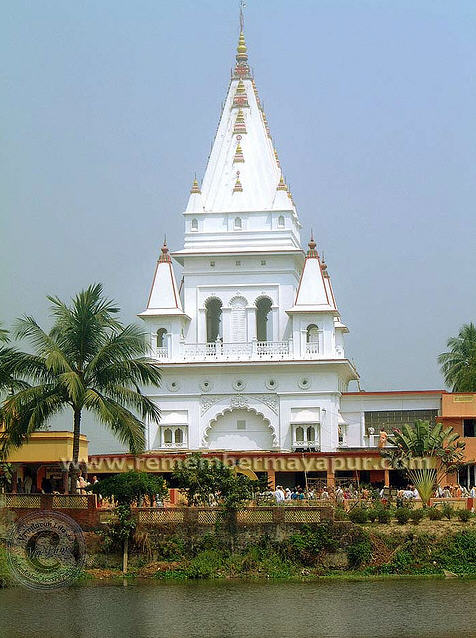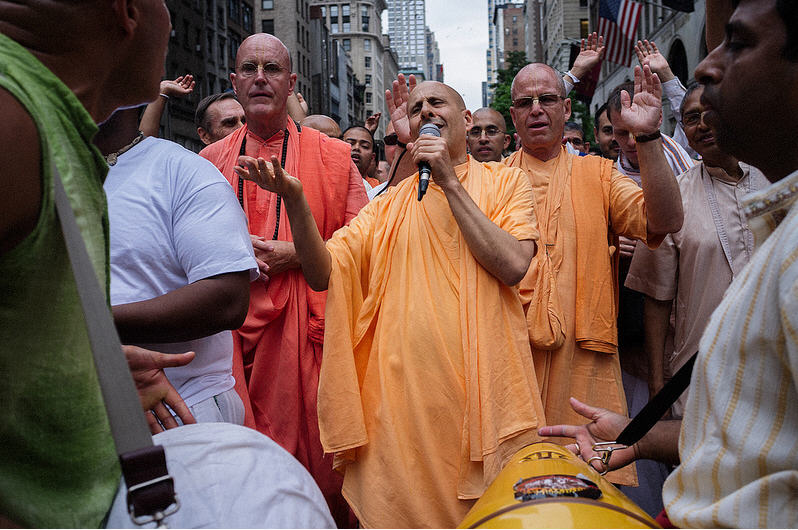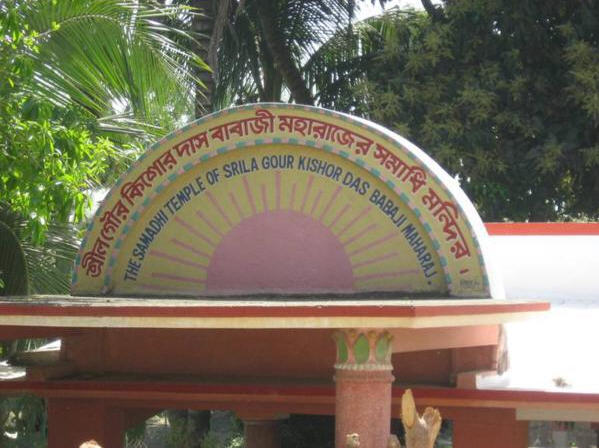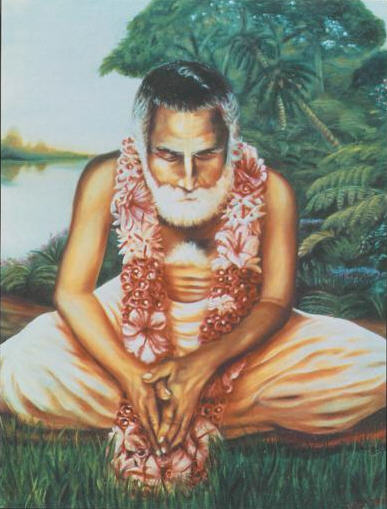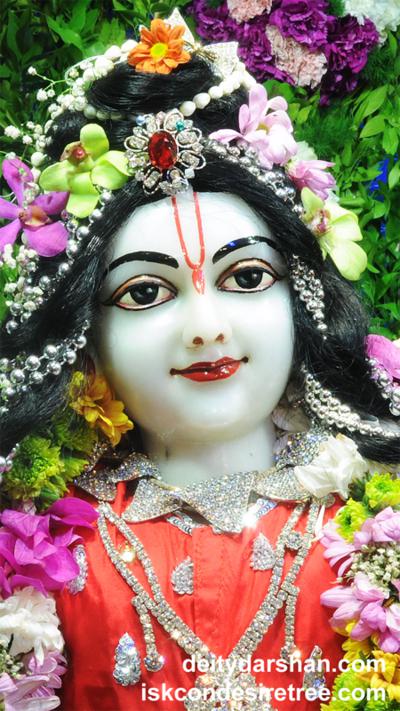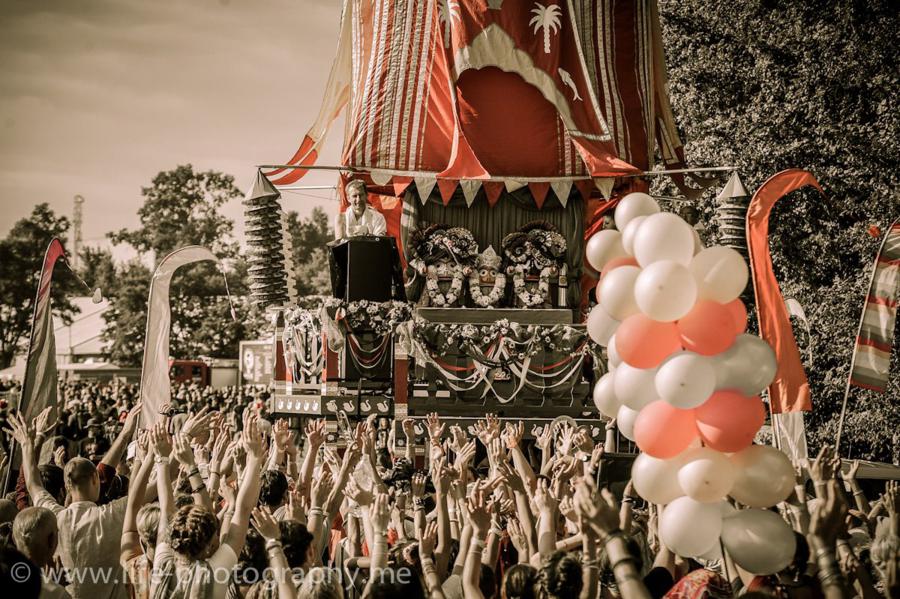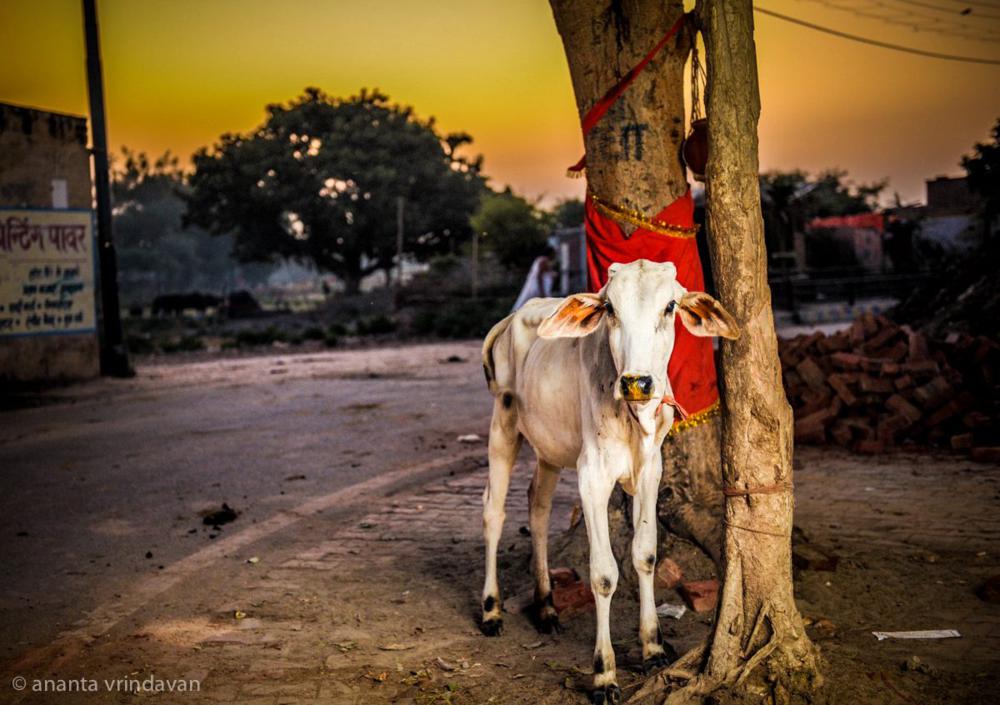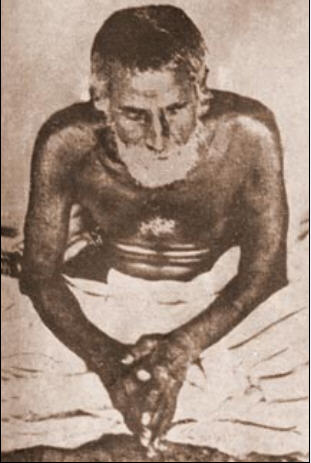
Gaura Kishora Dasa Babaji Maharaja.
vipralambha-rasambhodhe padambujaya te namah
I bow to your lotus feet, Shrila Gaura Kishora Das Babaji, the embodiment of renunciation and the ocean of sacred rapture in separation.
Early Life
Paramahamsa Shrila Gaura Kishora Das Babaji Maharaj was born into a Vaishya family on the banks of the Padma River in Bagayana village in Faridpur district in what is now Bangla Desh. The names of his parents are unknown. His given name was Vamshi Das. He was born sometime in the middle of the nineteenth century. He is important to us because he was the diksha guru of Shrila Bhaktisiddhanta Saraswati Goswami Prabhupada, founder of the Chaitanya Math and the world-wide Gaudiya Maths.
Vamshi Das’s parents had him married at an early age according to the custom of the time, but always remained detached from householder life. His main interest was always worshiping the Lord. When his wife died, he left home and went to Vrindavan where he took the paramahamsa-vesha from Bhagavata Das Babaji (a disciple of Shrila Jagannath Das Babaji Maharaj) and took the name Gaura Kishora Das Babaji.
Gaura Kishora Comes to Navadwip
After being initiated into the Babaji order, Gaura Kishora Das spent thirty years in Vraja engaged in intense religious practice. He also traveled outside of the Vraja area, visiting northern India and Bengal. While in the East, he met many of the leading Vaishnavas of Bengal and Orissa, such as Svarupa Das Babaji of Puri, Bhagavan Das Babaji of Kalna and Chaitanya Das Babaji of Kuliya.

In 1893, when the birthplace of Chaitanya Mahaprabhu was inaugurated at the Shri Mayapur Yoga Pith, Jagannath Das Babaji Maharaj ordered him to stay in Navadwip. This is where Gaura Kishora remained for the rest of his life. (In the image: Yoga Pitha-birth place of Lord Chaitanya, Mayapur).
In 1893, when the birthplace of Chaitanya Mahaprabhu was inaugurated at the Shri Mayapur Yoga Pith, Jagannath Das Babaji Maharaj ordered him to stay in Navadwip. This is where Gaura Kishora remained for the rest of his life. He saw all the residents of Navadwip with transcendental eyes, considering them to be divine beings. He thus accepted madhukari from them, cooking everything in a rejected clay bowl. It is said that sometimes he would subsist on nothing but Ganges water and mud. Sometimes he would go for long periods without eating, chanting the Holy Names constantly. He set the standard for those in the renounced order who live the life of solitary worship, remaining completely independent of others. Mahaprabhu’s personal envoy, Shrila Bhaktivinoda Thakur was extremely impressed by Gaura Kishora’s extraordinary renunciation, his pure devotion and his attachment to the Lord. Gaura Kishora would often go to Bhaktivinoda’s home in Godrumadwipa, Svananda-sukhada-kunja, where he would listen to him give readings of the Bhagavat and discuss Vaishnava theology with him.
Saraswati Thakura Meets Babaji Maharaj
Babaji Maharaj never accepted service from anyone. He constantly chanted the Holy Name, sometimes counting the names on a Tulasi mala, at other times by making knots on long strips of an old cloth. His favorite texts were Narottama Thakur’s Prarthana and Prema-bhakti-chandrika, which he considered to be his all-in-all. His renunciation resembled that of Raghunath Das Goswami and he possessed the same attachment to Krishna.
In 1898 AD, Gaura Kishora Das Babaji Maharaj met Shrila Bhaktisiddhanta Saraswati Goswami Thakur for the first time at Svananda-sukhad-kunja in Godrumadwipa. Saraswati Thakur was enchanted by Babaji Maharaj’s heartfelt emotional kirtan. He wrote the kirtan down and later taught it to his own disciples. The song describes Raghunath Das Goswami’s ecstatic separation from Radha.
kothay go premamayi radhe radhe
radhe radhe go, jaya radhe radhe
dekha diye prana rakha radhe radhe
tomara kangala tomaya dake radhe radhe
radhe vrindavana-vilasini radhe radhe
radhe kanu-mano-mohini radhe radhe
radhe ashta-sakhira shiromani radhe radhe
radhe vrishabhanu-nandini radhe radhe
(gosaïi) niyama kare sadai dake radhe radhe
(gosaïi) ekabara dake keshi-ghate radhe radhe
abara dake vamshi-bate radhe radhe
(gosaïi) ekabara dake nidhuvane radhe radhe
abara dake kuïja-vane radhe radhe
(gosaïi) ekabara dake radhakunde radhe radhe
abara dake shyama-kunde radhe radhe
(gosaïi) ekabara dake kusuma-vane radhe radhe
abara dake govardhane radhe radhe
(gosaïi) ekabara dake tala-vane radhe radhe
abara dake tamala-vane radhe radhe
(gosaïi) maline vasana diye gaya,
vrajera dhulaya gariagarii jaya, radhe radhe
(gosaïi) mukhe radha radha bale
bhese nayanera jale, radhe radhe
(gosaïi) vrindavane kulakuli
kende beriaya radha bali, radhe radhe
(gosaïi) chapanna danda ratri dine, jane na
radha-govinda bine, radhe radhe
tara para cari danda shuti thake svapne
radha-govinda dekhe, radhe radhe
Where is the incarnation of love, Radhe Radhe! Glories to Radha! Show yourself to me, Radha, give me back my life. I have become a beggar for you, Radha, and I am calling you. O Radha, you cavort in Vrindavan, you enchant Krishna’s mind, you are chief amongst the eight sakhis, and are the daughter of Vrishabhanu.
Raghunath Das Goswami regularly, constantly calls out to you, Radha. He calls for you in Keshi Ghat, in Vamshi Bata, Nidhuvana, Kunjavana, in Radha Kund and Shyama Kund, in Kusumavana and Govardhana, in Talavana and Tamalavana. He calls out wearing only a worn and dirty cloth and rolling in the Vrindavan dust. The names of Radha on his lips, his eyes are filled with tears. He wanders through every part of Vraja, calling Radha’s name. Night or day, for twenty-three hours he thinks of nothing but Radha and Govinda, and when he sleeps, he dreams of Radha and Govinda.
Gaura Kishora Initiates Shrila Prabhupada
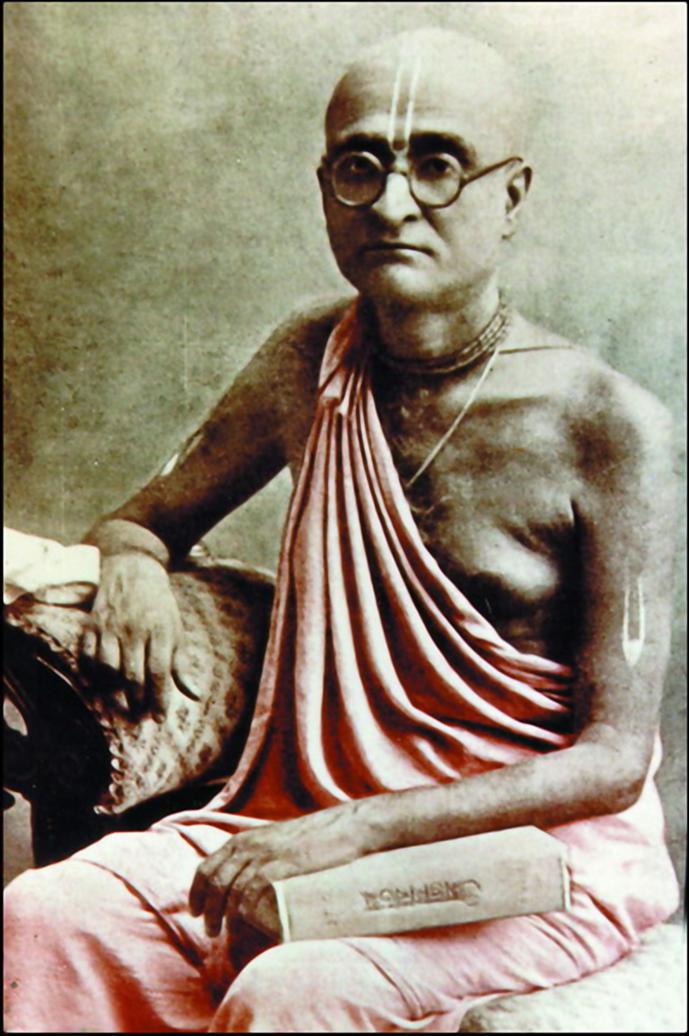
“In order to complete the gaping needs that I felt, I was busily trying to get my hands on everything under the sun. I thought that possessions would fulfill my needs. Over time, I had indeed accumulated a great number of rare possessions, but I was not able to rid myself of the sense of being unfulfilled...Fortunately, the supremely merciful Shri Gauranga Mahaprabhu allowed two of his dearest companions to show their kindness to me...From the time that I first met my Prabhu, my stubborn egoism started to diminish..." Bhaktisiddhanta Saraswati Thakur.
In January 1900, Shrila Bhaktisiddhanta Saraswati Goswami Thakur took initiation from Gaura Kishora Das Babaji on the instructions of Shrila Bhaktivinoda Thakur. Bhaktisiddhanta Saraswati was Babaji Maharaj’s only disciple. Babaji Maharaj was an anchorite who had sworn not to take any disciples, but he was forced to change his decision when he saw Saraswati Thakur’s determination and devotion.
The story is told that Shrila Prabhupada asked Gaura Kishora Das Babaji Maharaj several times to give him initiation. The first time he asked, Babaji Maharaj told him, “If Mahaprabhu tells me to, I will.”
The second time Babaji Maharaj told him that he had forgotten to ask Mahaprabhu. Shrila Prabhupada did not give up and came a third time, Babaji Maharaj said, “Virtuousness, scholarship and other qualities are not the means to attain the Lord. They do not give you any right to initiation.”
Though he had been turned back by Gaura Kishora Das Babaji repeatedly, Shrila Prabhupada did not abandon his resolution. Ramanujacharya was turned back eighteen times before receiving the mercy of Goshthipurna. Shrila Prabhupada showed his qualities of patience and determination continued to come to Babaji Maharaj, humbly entreating him to give him initiation until finally his heart melted and out of great affection mercifully initiated Shrila Prabhupada by sprinkling the dust of his lotus feet on his head.
Gaura Kishora Das Babaji would never allow any materialistic persons to touch his feet. If they did so, he would make a show of anger, saying, “You are doomed!” Most people were thus afraid to attempt it. On this occasion, however, he himself offered the dust of his feet to his dear disciple and smeared it on his body. From Shrila Prabhupada’s disciples, it is heard that he was turned back twelve times before Babaji Maharaj became compassionate and initiated him at his thirteenth request. Others say that it happened on the fourth time. This story reminds one of Narottama’s initiation by Lokanatha Goswami. Unswerving dedication to the guru is the sign of a disciple. Afterward, Babaji Maharaj, judging Shrila Prabhupada to be eminently qualified for the task, blessed him and ordered him to preach Mahaprabhu’s message all around the world.
Shrila Prabhupada Describes His Guru
Shrila Prabhupada wrote the following words about his guru, with exemplary humility, in order to show the world definitively the path of auspiciousness: “In order to complete the gaping needs that I felt, I was busily trying to get my hands on everything under the sun. I thought that possessions would fulfill my needs. Over time, I had indeed accumulated a great number of rare possessions, but I was not able to rid myself of the sense of being unfulfilled. I had encountered many personalities who were reputed to be great saints, but saw various lacunae in every one of them and so was unable to give them my respect. Fortunately, the supremely merciful Shri Gauranga Mahaprabhu allowed two of his dearest companions to show their kindness to me. I was egotistically so self-absorbed that I had completely lost any sense of where my well-being could be found. Even so, due to past pious activities, I was able to get the association of Shrila Bhaktivinoda Thakur who was my ever well-wisher. My Prabhu often came to visit him and sometimes stayed overnight at his house. Out of mercy to me, Shrila Bhaktivinoda Thakur introduced me to him. From the time that I first met my Prabhu, my stubborn egoism started to diminish. Previously, I used to think that everyone who took birth in a human body was filled with the same faults that I had, but upon seeing my Prabhu’s divine character I realized that there truly were flawless Vaishnavas in this world who matched the ideal.”
Shrila Prabhupada further wrote, “Many people who saw Gaura Kishora Das Babaji, whether innocent or experienced, young or old, learned or ignorant, or proud of their being advanced Devotees, were not able to truly see him. This is the divine power of Krishna’s Devotees. Hundreds of people came to him seeking help in fulfilling their material desires and he would give them advice, but this was a kind of deception. There are countless persons who take on the dress of a saintly person and make a show of acting like a saintly person, but on closer analysis are far from the standard. My Prabhu was not a cheater like them. It is clear from his spiritual activities that he identified complete honesty with the truth. His sincere affection was incomparable; it proved that the attainment of spiritual powers is a deception. He showed no enmity for those who opposed him or disagreed with him; similarly, he made no particular external show of affection for those who were objects of his compassion. He used to say, ‘I neither love nor hate anyone in this world; everyone is the object of my respect.’
“Amazingly, Prabhu would be surrounded by people with no understanding, fakers and materialists inimical to the path of pure devotion who thought themselves to be recipients of such a saintly person’s mercy, but continued to engage in sensual activities. Prabhu never openly rejected any of these people, but he never openly accepted any of them, either.”
Babaji Maharaj’s Disappearance
Babaji Maharaj was an expert judge of character and had highly-developed foresight and clairvoyance, often foretelling events in the distant future.
On the 30th of Karttik in 1322 (Bengali ’ 1915 AD), Paramahamsa Shrila Gaura Kishora Das Babaji entered the eternal pastimes of the Lord. At the time, he was residing at Ranira Dharma-shala in Kuliya. When Shrila Bhaktisiddhanta Saraswati Goswami Thakur received the news of his disappearance, he was overcome with feelings of separation from his guru and immediately hurried to the site of his departure. He was heart-broken to see that mahantas (abbots) of various akharias (ashramas) were busily arguing about where and how to bury his body. The idea of the Babajis was to lay claim to any future samadhi Temple as such a Temple would be an attractive pilgrimage site and a possible source of money-making. Shrila Prabhupada alone stood up and spoke out against this rascaldom. As things heated up, Navadwip’s chief of police, Jatindranath Singh Ray Bahadur, came to maintain the peace.
At that time, Shrila Prabhupada had not yet taken tridandi sannyas. The Babajis argued that as they had taken the renounced order, they had the right to perform the last rites for one of their order. As this was not the case for Shrila Prabhupada, he had no rights. Shrila Prabhupada displayed his spiritual strength and stated that he was Babaji Maharaj’s one and only disciple. He then asked them if there was any amongst them who had not had illicit sexual relations in the previous six months, or even in the previous three months, or one month, or even in the previous three days. He who had so done would be doomed if he touched Babaji Maharaj’s divine remains.
When he heard Shrila Prabhupada make this challenge, Jatindra Babu asked how anyone could prove whether or not he had had illicit sexual relations. Shrila Prabhupada answered that he would take anyone who came forward at his word. When the Babajis looked at the effulgence of pure spiritual practice emanating from Shrila Prabhupada, they slowly slunk away, one by one. The chief of police was embarrassed at this sight and he paid his obeisances to Shrila Prabhupada and then left himself.
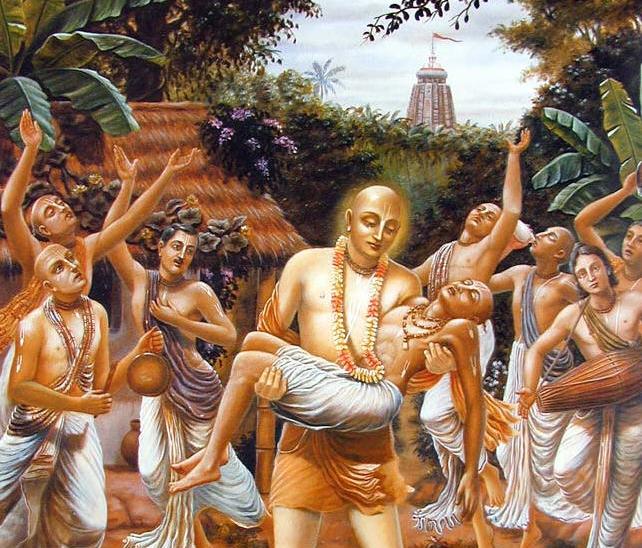
"...When Hari Das Thakur entered his eternal pastimes, Lord Gauranga took his body to his chest and danced with it. What a precedent he set for honoring the perfected soul’s departure! We would rather follow Mahaprabhu’s example and carry Siddha Baba’s divine remains on our head.” (In the image: Lord Chaitanya danced and cried lifting the body of Haridas Thakur).
Some residents of Kuliya told Shrila Prabhupada what Babaji Maharaj had said about his last desires. Apparently, he had stated that he wished his body to be dragged through the streets of Navadwip so that it would be covered by the dust of the Holy dham. Shrila Prabhupada replied, “This is my gurudeva. Even Krishna is honored to carry him on his shoulders and carries him like a crown upon his head. He said these things to confound the pride of the materialists with his humility. We may be inexperienced fools and offenders, but we should still make an effort to understand his intention. When Hari Das Thakur entered his eternal pastimes, Lord Gauranga took his body to his chest and danced with it. What a precedent he set for honoring the perfected soul’s departure! We would rather follow Mahaprabhu’s example and carry Siddha Baba’s divine remains on our head.”
On the first day of Agrahayan in Kuliya’s Nutana Caria, Shrila Prabhupada performed the samadhi rites for Shrila Gaura Kishora Das Babaji according to Vaishnava Smriti injunctions. A certain Poddar Mahashaya of Lohagaria in Jessore district gave the land for the samadhi, renouncing any claims on the property. Later, however, he reneged on his promise and came to live there himself and engaged in various illicit activities on the site. During the Ganges floods one season, the samadhi Temple was washed into the river. On the 5th of Bhadra, 1339 Bengali (1932 AD) Shrila Bhaktisiddhanta Saraswati Goswami Thakur retrieved some of his remains from the Ganges bed and took them to the Chaitanya Math where he established a samadhi Temple on the banks of Radha Kund. The site was consecrated on the 2nd of Ashvina, 1339 and in the course of time, a small Temple housing a murti of Gaura Kishora Das Babaji was constructed there. The murti’s nitya-seva has continued ever since.
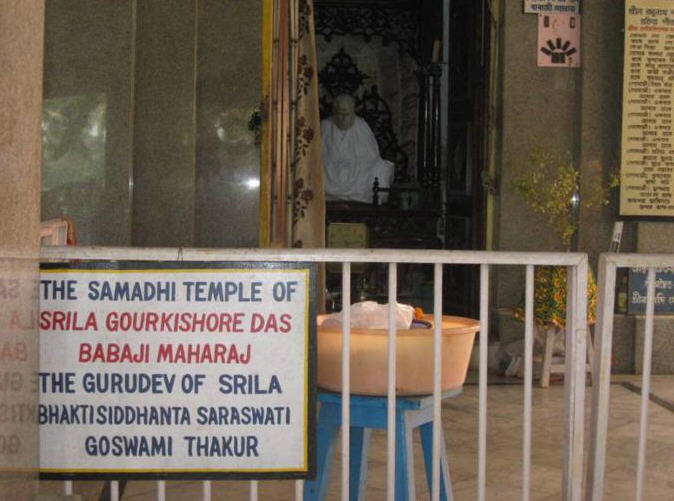
On the 5th of Bhadra, 1339 Bengali (1932 AD) Shrila Bhaktisiddhanta Saraswati Goswami Thakur retrieved some of his remains from the Ganges bed and took them to the Chaitanya Math where he established a samadhi Temple on the banks of Radha Kund. The site was consecrated on the 2nd of Ashvina, 1339 and in the course of time, a small Temple housing a murti of Gaura Kishora Das Babaji was constructed there. The murti’s nitya-seva has continued ever since.
Babaji Maharaj’s Teachings
Shrila Bhaktisiddhanta Saraswati Goswami Thakur told of a few events from Gaura Kishora Das Babaji’s life which are full of import for the practitioner of devotional life.
(1) On one occasion, a certain babaji came to visit Shrila Gaura Kishora Das Babaji with some of his followers in tow. These acolytes began glorifying their guru to Babaji Maharaj, “Our Prabhu is so merciful. He takes so much trouble to travel from place to place to deliver the poor, fallen souls. If he did not travel, what would be the destiny of these forsaken places?” Babaji Maharaj immediately became cross and answered, “If someone makes a pretense of delivering the world when in fact he is only interested in making money and garnering prestige, he not only does no one any good, but falls down for having cheated others.”
(2) One day, a few Devotees were describing the expertise of a particular lecturer on the Bhagavat. Babaji Mahashaya knew that this individual received money for his services. He said, “This fellow does not explain the Bhagavat or the scriptures of the Goswamis. He is simply speaking on the sense-gratification scriptures. He isn’t chanting ‘Gaura, Gaura!’ or ‘Krishna, Krishna!’, but ‘Money! Money!’. It has nothing to do with bhajana. The end result is that the true Vaishnava religion is obscured. Nothing good can come from it; indeed, the world will be harmed by such preaching.”
(3) One day Babaji Mahashaya was chanting japa late at night when he suddenly jumped up and exclaimed, “Did you see that? Did you see? A professional speaker on the Bhagavat has gone to Pabna district and has just made a chaste widow break her vows! What a shame! These rascals are giving Mahaprabhu’s religion a bad name.” He spoke as if he were personally witnessing the event.

“If you want my association, leave all your riches and come and live under a bamboo shelter like mine. You won’t have to worry about food. I will beg for enough to feed both of us. If I go to stay in your palace, it won’t be long before I start desiring to enjoy sense gratification. I will start thinking about how I can accumulate a property for myself. Then before you know it, I will become your enemy. If you want to preserve our friendship and if you wish to be kind to me as your Vaishnava friend, then you will come to the Dhama and join me in worshiping the Lord and eating madhukari.” (In the image: Brajabasi, Radha Kund, Vrindavan).
(4) The owner of the Navadwip Dharmashala was a certain Girisha Babu. One day, his wife offered to build a cottage for Babaji Maharaj. He answered, “I have no problem sleeping under the straw shelter on a boat. The only problem I have is that so many rascals are constantly coming to me asking me to bless them. They disturb my chanting. They don’t really want my blessings because they don’t really want what is best for them, but still they come to disrupt my chanting the Holy Name. If you give me your brick outhouse, I will be able to chant in peace. No one will come to bother me there.” When he realized that Babaji Mahashaya was serious, Girisha Babu immediately had the outhouse purified with cowdung and brought in a mason to completely redo the building.
(5) One day during the cold season, a Devotee made a gift of a quilt to Babaji Mahashaya, but rather than wrapping himself in it, he simply draped it over the tiny bamboo shelter under which he slept. When asked why he did that, he answered that the cold would go away simply upon seeing the quilt.
(6) One day the Raja of Cossim Bazar, Sir Manindra Chandra Nandi Bahadur, invited Babaji Maharaj to his palatial residence for a Vaishnava assembly. Babaji Mahashaya answered, “If you want my association, leave all your riches and come and live under a bamboo shelter like mine. You won’t have to worry about food. I will beg for enough to feed both of us. If I go to stay in your palace, it won’t be long before I start desiring to enjoy sense gratification. I will start thinking about how I can accumulate a property for myself. Then before you know it, I will become your enemy. If you want to preserve our friendship and if you wish to be kind to me as your Vaishnava friend, then you will come to the Dhama and join me in worshiping the Lord and eating madhukari.”
Gaura Kishora Das Babaji’s Favorite Song
Narottama Das Thakur’s songs were much beloved of Babaji Maharaj. He was often heard to sing one of them in particular. All the Vaishnava teachings can be found in this one song:
gaura pahu na bhajiya goinu
prema-ratana-dhana helaya harainu
I have invited my spiritual death by not worshiping Lord Chaitanya. Due to my neglect, I have lost the invaluable jewel of love for Krishna.
adhane yatana kari dhana teyaginu.
apana karama-doshe apani dubinu
I have rejected the real purpose of my life and given my attention to worthless things. I am drowning because of my own misdeeds.
sat-sanga charii kainu asate vilasa
te-karane lagila je karma-bandha-phansa
I have given up the association of Devotees, but I am associating with common nonsense men. And that is why the noose of karmic entanglement has been placed around my neck.
vishaya vishama visha satata khainu
gaura-kirtana-rase magana na painu
I have constantly drunk the most dangerous poison of sense gratification and so I could not merge myself into the sankirtan movement started by Lord Chaitanya.
keno va achaye prana ki sukha lagiya
narottama dasa kena na gela mariya
Why am I living? What pleasure is life bringing me? Narottama asks, “Why did I not die long, long ago?”
[Excerpted from “Sri Chaitanya: His Life & Associates” by Srila Bhakti Ballabh Tirtha Maharaj]
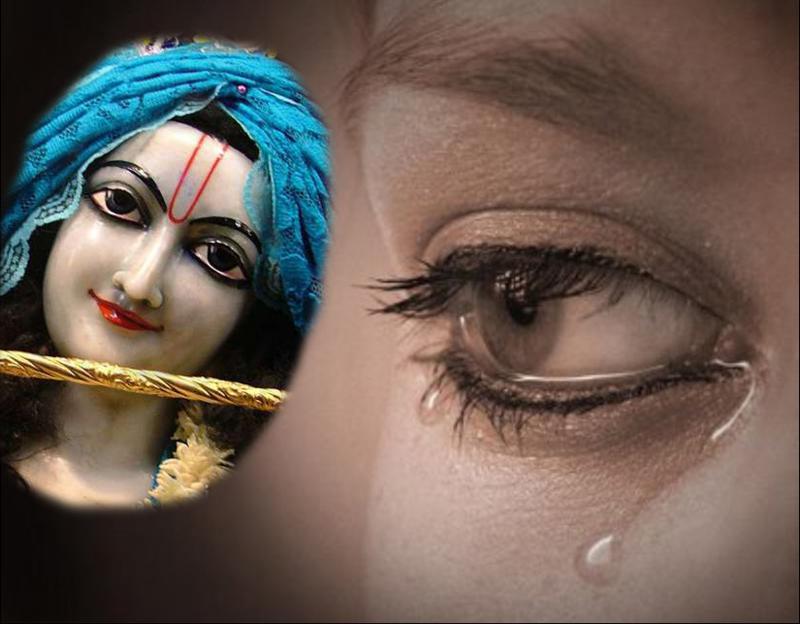
I have invited my spiritual death by not worshiping Lord Chaitanya. Due to my neglect, I have lost the invaluable jewel of love for Krishna. (In the wallpaper: Shri Gopinath, ISKCON Chowpatty, Mumbai).










